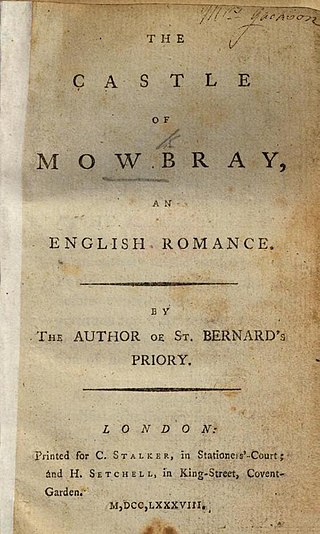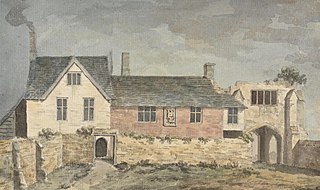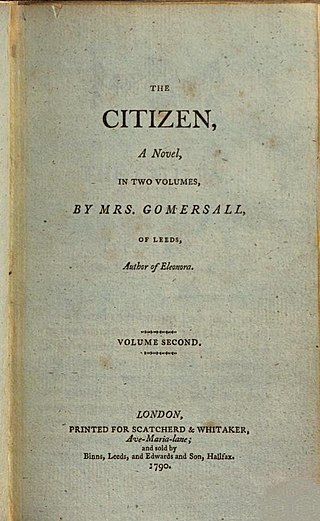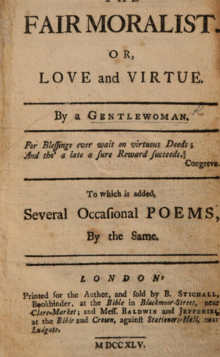
Sense and Sensibility is a novel by Jane Austen, published in 1811. It was published anonymously; By A Lady appears on the title page where the author's name might have been. It tells the story of the Dashwood sisters, Elinor and Marianne as they come of age. They have an older half-brother, John, and a younger sister, Margaret.
Sarah Fielding was an English author and sister of the novelist Henry Fielding. She wrote The Governess, or The Little Female Academy (1749), thought to be the first novel in English aimed expressly at children. Earlier she had success with her novel The Adventures of David Simple (1744).
Jane West, was an English novelist who published as Prudentia Homespun and Mrs. West. She also wrote conduct literature, poetry and educational tracts.
Mary Hays (1759–1843) was an autodidact intellectual who published essays, poetry, novels and several works on famous women. She is remembered for her early feminism, and her close relations to dissenting and radical thinkers of her time including Robert Robinson, Mary Wollstonecraft, William Godwin and William Frend. She was born in 1759, into a family of Protestant dissenters who rejected the practices of the Church of England. Hays was described by those who disliked her as 'the baldest disciple of [Mary] Wollstonecraft' by The Anti Jacobin Magazine, attacked as an 'unsex'd female' by clergyman Robert Polwhele, and provoked controversy through her long life with her rebellious writings. When Hays's fiancé John Eccles died on the eve of their marriage, Hays expected to die of grief herself. But this apparent tragedy meant that she escaped an ordinary future as wife and mother, remaining unmarried. She seized the chance to make a career for herself in the larger world as a writer.
Dale Spender is an Australian feminist scholar, teacher, writer and consultant. In 1983, Dale Spender was co-founder of and editorial advisor to Pandora Press, the first of the feminist imprints devoted solely to non-fiction, committed, according to the New York Times, to showing that "women were the mothers of the novel and that any other version of its origin is but a myth of male creation". She was the series editor of Penguin's Australian Women's Library from 1987. Spender's work is "a major contribution to the recovery of women writers and theorists and to the documentation of the continuity of feminist activism and thought". In the 1996 Australia Day honours, Spender was awarded Member of the Order of Australia "for service to the community as a writer and researcher in the field of equality of opportunity and equal status for women".
Sarah Green was an Irish-English author, one of the ten most prolific novelists of the first two decades of the nineteenth century.
Laetitia Matilda Hawkins was an English novelist, associated with Twickenham. She was the daughter of Sir John Hawkins, an acquaintance of Samuel Johnson.

Martha Harley was the successful author of six Gothic novels.
The academic discipline of women's writing is a discrete area of literary studies which is based on the notion that the experience of women, historically, has been shaped by their sex, and so women writers by definition are a group worthy of separate study: "Their texts emerge from and intervene in conditions usually very different from those which produced most writing by men." It is not a question of the subject matter or political stance of a particular author, but of her sex, i.e. her position as a woman within the literary world.

The reception history of Jane Austen follows a path from modest fame to wild popularity. Jane Austen (1775–1817), the author of such works as Pride and Prejudice (1813) and Emma (1815), has become one of the best-known and most widely read novelists in the English language. Her novels are the subject of intense scholarly study and the centre of a diverse fan culture.
Jane Austen's (1775–1817) distinctive literary style relies on a combination of parody, burlesque, irony, free indirect speech and a degree of realism. She uses parody and burlesque for comic effect and to critique the portrayal of women in 18th-century sentimental and Gothic novels. Austen extends her critique by highlighting social hypocrisy through irony; she often creates an ironic tone through free indirect speech in which the thoughts and words of the characters mix with the voice of the narrator. The degree to which critics believe Austen's characters have psychological depth informs their views regarding her realism. While some scholars argue that Austen falls into a tradition of realism because of her finely executed portrayal of individual characters and her emphasis on "the everyday", others contend that her characters lack a depth of feeling compared with earlier works, and that this, combined with Austen's polemical tone, places her outside the realist tradition.
Susanna Keir, née Harvey was a British novelist. Her two novels, "largely in epistolatory form, are long on moralizing and short on action."
Anne Burke was an Irish novelist in the Gothic genre. She was one of the earliest women writers of Gothic fiction.
E. M. Foster was a Romantic-era woman novelist. Some 14 popular novels of hers appeared in London between 1795 and 1810.
Mary Champion de Crespigny was an English novelist and letter writer.

Margaret Minifie was a "a minor eighteenth-century sentimental novelist" whose career has tended to have been overshadowed by that of her sister, Susannah Gunning. A number of Minifie's works have historically been attributed to Gunning but recently, critics have sought to disentangle their two histories.

Ann Gomersall was a British novelist of the Romantic-era who paid close attention to economic and social issues in her writing.

Mothers of the Novel: 100 Good Women Writers Before Jane Austen (1986), by Dale Spender, is a foundational study for the reclamation project central to feminist literary studies in English in the late 1980s and 1990s.






